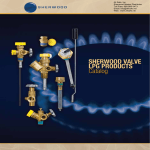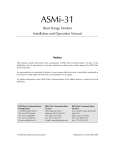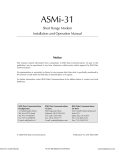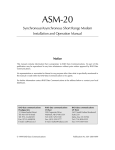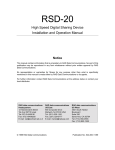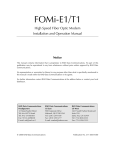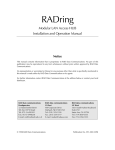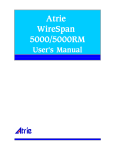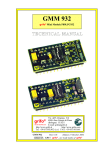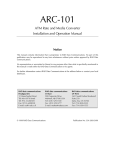Download RAD Data comm AMC-101 Specifications
Transcript
AMC-101 Universal Media Converter and Repeater Installation and Operation Manual Notice This manual contains information that is proprietary to RAD Data Communications. No part of this publication may be reproduced in any form whatsoever without prior written approval by RAD Data Communications. No representation or warranties for fitness for any purpose other than what is specifically mentioned in this manual is made either by RAD Data Communications or its agents. For further information contact RAD Data Communications at the address below or contact your local distributor. RAD data communications Headquarters 12 Hanechoshet Street Tel Aviv 69710 Israel Tel: 972-3-6458181 Fax: 972-3-6498250 E-mail: [email protected] RAD data communications US East 900 Corporate Drive Mahwah, NJ 07430 USA Tel: (201) 529-1100 Fax: (201) 529-5777 E-mail: [email protected] © 2000 RAD Data Communications RAD data communications US West 3631 South Harbor Boulevard Suite 250 Santa Ana, CA 92704 Tel: (714) 850-0555 Fax: (714) 850-1555 Publication No. 333-200-06/00 Warranty This RAD product is warranted against defects in material and workmanship for a period of one year from date of shipment. During the warranty period, RAD will, at its option, either repair or replace products which prove to be defective. For warranty service or repair, this product must be returned to a service facility designated by RAD. Buyer shall prepay shipping charges to RAD and RAD shall pay shipping charges to return the product to Buyer. However, Buyer shall pay all shipping charges, duties and taxes for products returned to RAD from another country. Limitation of Warranty The foregoing warranty shall not apply to defects resulting from improper or inadequate maintenance by Buyer, Buyer-supplied firmware or interfacing, unauthorized modification or misuse, operation outside of the environmental specifications for the product, or improper site preparation or maintenance. Exclusive Remedies The remedies provided herein are the Buyer’s sole and exclusive remedies. RAD shall not be liable for any direct, indirect special, incidental, or consequential damages, whether based on contract, tort, or any legal theory. Safety Warnings The exclamation point within a triangle is intended to warn the operator or service personnel of operation and maintenance factors relating to the product and its operating environment which could pose a safety hazard. Always observe standard safety precautions during installation, operation and maintenance of this product. Only qualified and authorized service personnel should carry out adjustment, maintenance or repairs to this instrument. No adjustment, maintenance or repairs should be performed by either the operator or the user. Telecommunication Safety The safety status of each of the ports on the AMC-101 is declared according to EN 41003 and is detailed in the table below: Safety Status SELV* TNV** TNV operating within the limits of SELV Limited current ELV*** Excessive voltage * ** *** Ports V.11, V.24, V.35, V.36, X.21, X.50, LAN FXO, FXS, E&M ISDN, E1, T1, sub E1, sub T1, various outputs to modem None None None SELV = Safety Extra-Low Voltage TNV = Telecommunications Network Voltage ELV = Extra-Low Voltage Regulatory Information FCC-15 User Information This equipment has been tested and found to comply with the limits of the Class A digital device, pursuant to Part 15 of the FCC rules. These limits are designed to provide reasonable protection against harmful interference when the equipment is operated in a commercial environment. This equipment generates, uses and can radiate radio frequency energy and, if not installed and used in accordance with the instruction manual, may cause harmful interference to the radio communications. Operation of this equipment in a residential area is likely to cause harmful interference in which case the user will be required to correct the interference at his own expense. Warning per EN 55022 This is a Class A product. In a domestic environment, this product may cause radio interference, in which case the user may be required to take adequate measures. Declaration of Conformity Manufacturer’s Name: RAD Data Communications Ltd. Manufacturer’s Address: 12 Hanechoshet St. Tel Aviv 69710 Israel declares that the product: Product Name: AMC-101 Conforms to the following standard(s) or other normative document(s): EMC: Safety: EN 55022 (1994) Limits and methods of measurement of radio disturbance characteristics of information technology equipment. EN 50082-1 (1992) Electromagnetic compatibility - Generic immunity standards for residential, commercial and light industry. EN 60950 (1992/93) Safety of information technology equipment, including electrical business equipment. Supplementary Information: The product herewith complies with the requirements of the EMC Directive 89/336/EEC and the Low Voltage Directive 73/23/EEC. The product was tested in a typical configuration. Tel Aviv, October 10th, 1996 Haim Karshen VP Quality European Contact: RAD Data Communications GmbH, Lyoner Strasse 14, 60528 Frankfurt am Main, Germany Contents CHAPTER 1 – INTRODUCTION 1.1 General ............................................................................................................................................. 1-1 Retimed Modules ................................................................................................................................. 1-1 Transparent Modules ............................................................................................................................ 1-1 1.2 Features ............................................................................................................................................ 1-2 1.3 General Applications......................................................................................................................... 1-3 1.4 Fast Ethernet Applications................................................................................................................. 1-6 1.5 Specifications .................................................................................................................................. 1-10 Indicators ........................................................................................................................................... 1-10 Controls.............................................................................................................................................. 1-10 Power................................................................................................................................................. 1-10 Physical .............................................................................................................................................. 1-10 Environment ....................................................................................................................................... 1-10 CHAPTER 2 – INSTALLATION & SETUP 2.1 Unpacking......................................................................................................................................... 2-1 Before Unpacking ................................................................................................................................. 2-1 Unpacking Procedure ........................................................................................................................... 2-1 2.2 Site Requirements ............................................................................................................................. 2-1 Power................................................................................................................................................... 2-1 Front and Rear Panel Clearance ............................................................................................................ 2-1 Ambient Requirements ......................................................................................................................... 2-1 Installation of a Single Unit.................................................................................................................... 2-2 Installation of Two Units ....................................................................................................................... 2-3 2.3 Cable Connections ............................................................................................................................ 2-4 AC Power Connection .......................................................................................................................... 2-4 Grounding ............................................................................................................................................ 2-4 2.4 AMC-101 Modules ............................................................................................................................ 2-5 MM/SC/13/R Module............................................................................................................................ 2-5 MM/SC/13/T Module ............................................................................................................................ 2-6 MM/ST/13/R Module ............................................................................................................................ 2-7 MM/ST/13/T Module ............................................................................................................................ 2-8 SM/ST/13/R Module.............................................................................................................................. 2-9 SM/ST/13/T Module............................................................................................................................ 2-10 SM/FC/13/T Module ........................................................................................................................... 2-11 SM/ST/13L/R Module.......................................................................................................................... 2-12 SM/ST/13L/T Module .......................................................................................................................... 2-13 SM/SC/13L/R Module ......................................................................................................................... 2-14 AMC-101 Installation and Operation Manual i Contents SM/ST/13LH/R Module ....................................................................................................................... 2-15 SM/FC/13LH/R Module....................................................................................................................... 2-16 SM/ST/15L/R Module.......................................................................................................................... 2-17 SM/ST/15LH/R Module ....................................................................................................................... 2-18 SM/FC/15LH/R Module....................................................................................................................... 2-19 MM/ST/85/T Module .......................................................................................................................... 2-20 SF1/ST/R Module ................................................................................................................................ 2-21 SF2/ST/R Module ................................................................................................................................ 2-22 SF1/FC/R Module................................................................................................................................ 2-23 SF2/FC/R Module................................................................................................................................ 2-24 CX/BNC/155/R Module....................................................................................................................... 2-25 CX/DIN/155/R Module ....................................................................................................................... 2-26 STP/155/R Module.............................................................................................................................. 2-27 STP/155/T Module.............................................................................................................................. 2-28 UTP/155/R Module............................................................................................................................. 2-29 UTP/155/T Module............................................................................................................................. 2-30 UTP/100/R Module............................................................................................................................. 2-31 UTP/100/T Module............................................................................................................................. 2-32 100BT/B Module ................................................................................................................................ 2-33 100BT/R Module ................................................................................................................................ 2-34 10BT/B Module .................................................................................................................................. 2-35 CHAPTER 3 – OPERATION 3.1 Controls and Indicators .................................................................................................................... 3-1 3.2 Dry Contact Circuit and Connector for Alarms................................................................................. 3-3 3.3 Turning On AMC-101 ....................................................................................................................... 3-4 3.4 Normal Operation ............................................................................................................................ 3-5 3.5 Turning Off AMC-101 ....................................................................................................................... 3-5 3.6 Troubleshooting Procedures............................................................................................................. 3-5 The POWER LED does not light ............................................................................................................ 3-5 Data transmission difficulties ................................................................................................................. 3-5 ii AMC-101 Installation and Operation Manual Contents List of Figures Figure 1-1 Dissimilar Device Connectivity .................................................................................................. 1-3 Figure 1-2 Dual Similar Device Connectivity............................................................................................... 1-3 Figure 1-3 WRAP: Dual Single Mode (SM) to Multimode (MM) Conversion ............................................... 1-4 Figure 1-4 Single Interface SM to MM (Wrap) ............................................................................................. 1-4 Figure 1-5 FDDI and Fast Ethernet Operations............................................................................................ 1-5 Figure 1-6 Half Duplex Point-to-Point Connection...................................................................................... 1-6 Figure 1-7 Extending Half Duplex Point-to-Point Connection...................................................................... 1-6 Figure 1-8 Repeater Half Duplex Connection over UTP .............................................................................. 1-7 Figure 1-9 Extending Repeater Half Duplex Connection ............................................................................. 1-7 Figure 1-10 Point-to-Point Full Duplex Connection..................................................................................... 1-8 Figure 1-11 Extending Point-to-Point Full Duplex Connection..................................................................... 1-8 Figure 1-12 Full Duplex Connection over UTP........................................................................................... 1-9 Figure 1-13 Extending Full Duplex Connection ........................................................................................... 1-9 Figure 2-1 AMC-101 Rear Panel AC Version............................................................................................... 2-2 Figure 2-2 AMC-101 Rear Panel DC Version .............................................................................................. 2-2 Figure 2-3 Installation of a Single Unit ........................................................................................................ 2-2 Figure 2-4 Installation of Two Units (a) ....................................................................................................... 2-3 Figure 2-5 Installation of Two Units (b) ....................................................................................................... 2-4 Figure 2-6 MM/SC/13/R Module Front Panel .............................................................................................. 2-5 Figure 2-7 MM/SC/13/T Module Front Panel .............................................................................................. 2-6 Figure 2-8 MM/ST/13/R Module Front Panel............................................................................................... 2-7 Figure 2-9 MM/ST/13/T Module Front Panel............................................................................................... 2-8 Figure 2-10 SM/ST/13/R Module Front Panel .............................................................................................. 2-9 Figure 2-11 SM/ST/13/T Module Front Panel ............................................................................................ 2-10 Figure 2-12 SM/FC/13/T Module Front Panel............................................................................................ 2-11 Figure 2-13 SM/ST/13L/R Module Front Panel .......................................................................................... 2-12 Figure 2-14 SM/ST/13L/T Module Front Panel .......................................................................................... 2-13 Figure 2-15 SM/SC/13L/R Module Front Panel.......................................................................................... 2-14 Figure 2-16 SM/ST/13LH/R Module Front Panel ....................................................................................... 2-15 Figure 2-17 SM/FC/13LH/R Module Front Panel ....................................................................................... 2-16 Figure 2-18 SM/ST/15L/R Module Front Panel .......................................................................................... 2-17 Figure 2-19 SM/ST/15LH/R Module Front Panel ....................................................................................... 2-18 Figure 2-20 SM/FC/15LH/R Module Front Panel ....................................................................................... 2-19 Figure 2-21 MM/ST/85/T Module Front Panel........................................................................................... 2-20 Figure 2-22 SF1/ST/R Module Front Panel ................................................................................................ 2-21 Figure 2-23 SF2/ST/R Module Front Panel ................................................................................................ 2-22 Figure 2-24 SF1/FC/R Module Front Panel ................................................................................................ 2-23 Figure 2-25 SF2/FC/R Module Front Panel ................................................................................................ 2-24 Figure 2-26 CX/BNC/155/R Module Front Panel ....................................................................................... 2-25 Figure 2-27 CX/DIN/155/R Module Front Panel ........................................................................................ 2-26 Figure 2-28 STP/155/R Module Front Panel .............................................................................................. 2-27 Figure 2-29 STP/155/T Module Front Panel .............................................................................................. 2-28 Figure 2-30 UTP/155/R Module Front Panel ............................................................................................. 2-29 Figure 2-31 UTP/155/T Module Front Panel ............................................................................................. 2-30 Figure 2-32 UTP/100/R Module Front Panel ............................................................................................. 2-31 Figure 2-33 UTP/100/T Module Front Panel ............................................................................................. 2-32 Figure 2-34 100BT/B Module Front Panel................................................................................................. 2-33 Figure 2-35 100BT/R Module Front Panel................................................................................................. 2-34 AMC-101 Installation and Operation Manual iii List of Tables Figure 2-36 10BT/B Module Front Panel................................................................................................... 2-35 Figure 3-1 AMC-101 Front Panel................................................................................................................ 3-1 Figure 3-2 Jumper Locations and Functions ................................................................................................ 3-2 Figure 3-3 Connector Pin Assignment .......................................................................................................... 3-3 Figure 3-4 AMC-101 Block Diagram........................................................................................................... 3-4 List of Tables Table 1-1 Table 1-2 Table 1-3 Table 2-1 Table 2-2 Table 2-3 Table 2-4 Table 2-5 Table 2-6 Table 2-7 Table 2-8 Table 2-9 Table 3-1 Table 3-2 Table 3-3 Table 3-4 iv Optical Module Characteristics .................................................................................................. 1-11 Electrical Module Characteristics ................................................................................................ 1-13 Bridging Modules ...................................................................................................................... 1-13 STP/155/R Pinout ...................................................................................................................... 2-27 STP/155/T Pinout ...................................................................................................................... 2-28 UTP/155/R Pinout ..................................................................................................................... 2-29 UTP/155/T Pinout ..................................................................................................................... 2-30 UTP/100/R Pinout ..................................................................................................................... 2-31 UTP/100/T Pinout ..................................................................................................................... 2-32 100BT/B Module Pinout ............................................................................................................ 2-33 100BT/R Module Pinout ............................................................................................................ 2-34 10BT/B Module Pinout .............................................................................................................. 2-35 AMC-101 Front Panel Indicators .................................................................................................. 3-1 AMC-101 Front Panel Controls .................................................................................................... 3-1 Functions and Settings ................................................................................................................. 3-2 Connector Pin Assignment ........................................................................................................... 3-3 AMC-101 Installation and Operation Manual Chapter 1 Introduction 1.1 General The AMC-101, a Universal Converter and Repeater, provides retimed or transparent conversion of optical and electrical signals for ATM, FDDI, Fast Ethernet and other protocols at data rates up to 155 Mbps. The modularity of the AMC-101 interfaces enables field-changeable conversion between any two media. Transparent modules provide cost-effective media conversion without reclocking. Retimed modules provide media conversion with reclocking, which enables the AMC-101 to be used as a repeater. These modules can also be set for transparent operation. AMC-101 is supplied as a standalone unit. Special hardware for mounting either a single unit or two units side-by-side in a 19" rack can be ordered separately. Retimed Modules The AMC-101 provides retimed media conversion for the following ATM interfaces: • TAXI (100 Mbps) • STM-1 • STS-3c • STS-1 over optical and electrical interfaces. Retimed conversion is also available for FDDI and Fast Ethernet between single mode and multimode fiber, and for extending FDDI UTP connections over fiber. The retimed modules provide rate selection for 51, 100 or 155 Mbps. When set to one of these rates, the retimed module regenerates and reclocks the incoming signal and acts as an ATM or FDDI repeater. When the switch is set to "OTHER", the modules regenerate the signal without reclocking as transparent modules do. Transparent Modules The AMC-101 provides transparent conversion for any two-level optical protocol. Transparent modules are recommended for short distances and for all fiber and copper applications at less than 100 Mbps. A special WRAP button activates loopbacks at the two interfaces. This can be used for test purposes or for special applications as explained later. General 1-1 AMC-101 Installation & Operation Manual Chapter 1 - Introduction 1.2 Features Modular Media Converter and Repeater, Media types supported: • Single Mode Fiber • Multimode Fiber • STP • UTP • Coax Retimed media conversion for 51 Mbps, 100 Mbps and 155 Mbps. Transparent media conversion up to 155 Mbps. In retimed mode can be used as a Fiber Optic or copper repeater Protocols supported in retimed mode: • 51 Mbps OC-1 • 100 Mbps TAXI • 155 Mbps OC-3 • 155 Mbps STS-3c over UTP/STP • 155 Mbps STS-3c/STM-1 over Coax • FDDI • 100BaseT (Fast Ethernet). Transparent mode supports any two-level optical protocol including: • Ethernet • Token Ring • Protocols supported in retimed mode (fiber and copper) performed at less than 100 Mbps. Complies with ATM forum specifications. Multiple connector types are available for both electrical and optical interfaces. 1-2 Features AMC-101 Installation & Operation Manual Chapter 1 - Introduction 1.3 General Applications A single AMC-101 is used to connect two devices operating with different fiber or electrical interfaces (see Figure 1-1). UTP Cat 5 1300 nm 155 Mbps ATM Station Single Mode Fiber AMC-101 ATM Switch Figure 1-1 Dissimilar Device Connectivity A pair of AMC-101s connect two similar devices over different media types (see Figure 1-2). Coax 155 Mbps Coax 155 Mbps AMC-101 ATM Switch MMF 1300 nm PTT Single Mode 1300 nm AMC-101 FDDI AMC-101 MMF 1300 nm AMC-101 MMF 850 nm FDDI MMF 850 nm Token Ring AMC-101 ATM Switch Token Ring AMC-101 Figure 1-2 Dual Similar Device Connectivity General Applications 1-3 AMC-101 Installation & Operation Manual Chapter 1 - Introduction A single AMC-101 in WRAP mode can be used for double conversion between single mode and multimode fiber for a dual attached FDDI station or concentrator (see Figure 1-3). Figure 1-3 WRAP: Dual Single Mode (SM) to Multimode (MM) Conversion A single AMC-101 equipped with a single interface in WRAP mode can be used for conversion between single mode and multimode fiber (see Figure 1-4). 1300 nm Multimode 1300 nm Single Mode ATM Switch ATM Switch AMC-101 in WRAP Mode Figure 1-4 Single Interface SM to MM (Wrap) 1-4 General Applications AMC-101 Installation & Operation Manual Chapter 1 - Introduction The FDDI applies scrambling to data when operating over UTP, but not doing so when operating over fiber. Because of this, AMC-101 can only work in pairs for extending FDDI connections over fiber (see Figure 1-5). Fiber UTP Cat 5 FDDI AMC-101 UTP Cat 5 AMC-101 FDDI Figure 1-5 FDDI and Fast Ethernet Operations General Applications 1-5 AMC-101 Installation & Operation Manual Chapter 1 - Introduction 1.4 Fast Ethernet Applications • Point to Point Link using a pair of Fiber Optic Cables running in HD (Half Duplex) 100-BaseFX: Problem: In a point to point application, in HD, the maximum range is limited to 412m. Fiber Optic Link Up to 412m Server Printer Fiber Optic Link Up to 412m Laptop PC Figure 1-6 Half Duplex Point-to-Point Connection Solution: Using two AMC-M/100BT/B modules can extend the range up to tens of kilometers. Fiber Optic Link UTP Server AMC-101 with AMC-M/100BT/B AMC-101 with AMC-M/100BT/B Fiber Optic Link UTP PC UTP Up to tens of kilometers Printer UTP Up to tens of kilometers AMC-101 with AMC-M/100BT/B AMC-101 with AMC-M/100BT/B Laptop Figure 1-7 Extending Half Duplex Point-to-Point Connection 1-6 Fast Ethernet Applications AMC-101 Installation & Operation Manual • Chapter 1 - Introduction Repeater based LAN Link using standard UTP at HD (Half Duplex). Problem: Range is limited to 100m from the repeater. UTP Up to 100m Fast Ethernet Station (Laptop) Repeater UTP Up to 100m Fast Ethernet Station Figure 1-8 Repeater Half Duplex Connection over UTP Solution: Using two AMC-101s with AMC-M/100BT/B modules can extend the range up to tens of kilometers. UTP Up to 100m Fast Ethernet Station (Laptop) Repeater UTP < 80m Fiber Optic Link UTP < 80m Up to tens of kilometers AMC-101 AMC-101 Fast Ethernet Station with AMC-M/100BT/B Module with AMC-M/100BT/B Module Figure 1-9 Extending Repeater Half Duplex Connection Fast Ethernet Applications 1-7 AMC-101 Installation & Operation Manual Chapter 1 - Introduction • Extension of a point to point FD (Full Duplex) Fast Ethernet connection: Problem: The distance between two FD stations running on UTP needs to be extended. UTP Up to 100m FD Fast Ethernet Station FD Fast Ethernet Station Figure 1-10 Point-to-Point Full Duplex Connection Solution: Using two AMC-101s with AMC-M/100BT/R modules can extend the range up to tens of kilometers. FD Fiber Optic Link UTP UTP Up to 80m Up to 80m Up to tens of kms FD Fast Ethernet Station FD Fast Ethernet Station AMC-101 with AMC-101 with AMC-M/100BT/R Module AMC-M/100BT/R Module Figure 1-11 Extending Point-to-Point Full Duplex Connection 1-8 Fast Ethernet Applications AMC-101 Installation & Operation Manual • Chapter 1 - Introduction Extension of a Switched Based Fast Ethernet LAN (FD - Full Duplex) Problem: The range of a FD Fast Ethernet LAN running on UTP has to be extended. UTP Up to 100m IBM Printer UTP Up to 100m Fast Ethernet Laptop Station FD Fast Ethernet Switch UTP Up to 100m Fast Ethernet Station Figure 1-12 Full Duplex Connection over UTP Solution: Using AMC-101s with AMC-M/100BT/R modules can extend the range up to tens of kilometers. Fiber Optic Link Up to tens of kilometers Printer with Fiber Optic Transceiver Running FD Fast Ethernet AMC-101 with AMC-M/100BT/R Module UTP < 80m UTP Up to 100m UTP < 80m FD Fast Ethernet Switch FD Fast Ethernet Station (Laptop) Fiber Optic Link UTP < 80m AMC-101 FD Fast Ethernet Station with AMC-M/100BT/R Module Up to tens of kilometers AMC-101 with AMC-M/100BT/R Module Figure 1-13 Extending Full Duplex Connection Specifications 1-9 AMC-101 Installation & Operation Manual Chapter 1 - Introduction 1.5 Specifications Indicators Controls Power Physical Environment 1-10 Specifications Data Rate Up to 155 Mbps POWER (PWR) ON when unit is powered FAULT (FLT) BLINKS when card configuration is wrong WRAP ON when the two interfaces are wrapped SIG ON when received signal from Rx is valid BLINKS when the PLL is out of lock WRAP For double conversion or test purposes RATE For data rate selection 51, 100, 155 Mbps OTHER For transparent mode AC source 90-260 VAC, 16 ± 0.4 Watts, 47-63 Hz DC source -48 VDC Height 4.4 cm / 1.8 in (1U) Width 21.6 cm / 8.5 in Depth 24.2 cm / 9.5 in Weight 1.1 kg / 2.8 lb Temperature 0o-50oC/32o-122oF Humidity Up to 95%, non-condensing AMC-101 Installation & Operation Manual Chapter 1 - Introduction Table 1-1 Optical Module Characteristics Module Name MM/ST/85* MM/SC/13** MM/ST/13** SF1/FC*** SF2/FC*** SF1/ST*** SF2/ST*** SM/FC/13** SM/FC/13L** (LASER) Protocols Supported Fiber Type Connector Typical Dynamic (Wavelength) Type Distance Range Optical Sensitivity Power (Typical) Token Ring, Ethernet only 62.5/125 (850 nm) ST 18 dB -18 dBm -30 dBm TAXI, FDDI, Fast Ethernet, STS-1, STS3c/STM-1 62.5/125 (1300 nm) SC 17 dB -18 dBm -31 dBm TAXI, FDDI, 62.5/125 Fast Ethernet (1300 nm) STS-3c/STM-1, STS-1 ST 17 dB -18 dBm -31 dBm TAXI, FDDI, 9/125 Fast Ethernet, Transmit STS-3c/STM-1, 1300 nm STS-1 Receive 1550 nm FC-PC 40 Km / 28 dB -12 dBm -29 dBm (Single Strand) 24.8 mile TAXI, FDDI, 9/125 Fast Ethernet, Transmit STS-3c/STM-1, 1550 nm STS-1 Receive 1300 nm FC-PC 40 Km / 28 dB -12 dBm -29 dBm (Single Strand) 24.8 mile TAXI, FDDI, 9/125 Fast Ethernet, Transmit STS-3c/STM-1, 1300 nm STS-1 Receive 1550 nm ST 40 Km / 28 dB -12 dBm -29 dBm (Single Strand) 24.8 mile TAXI, FDDI, 9/125 Fast Ethernet, Transmit STS-3c/STM-1, 1550 nm STS-1 Receive 1300 nm ST 40 Km / 28 dB -12 dBm -29 dBm (Single Strand) 24.8 mile TAXI, FDDI, 9/125 Fast Ethernet, 1300 nm STS-3c/STM-1/ STS-1 FC-PC 25 Km / 30 dB -15 dBm -31 dBm TAXI, FDDI, 9/125 Fast Ethernet, 1300 nm STS-3c/STM-1/ STS-1 FC-P 30 dB -12 dBm -31 dBm 2 Km / 1.2 mile 2 Km / 1.2 mile 2 Km / 1.2 mile 15.5 mile 40 Km / 24.8 mile Specifications 1-11 AMC-101 Installation & Operation Manual Chapter 1 - Introduction Table 1-1 Optical Module Characteristics (Cont.) Module Name Protocols Supported Fiber Type Connector Typical Dynamic (Wavelength) Type Distance Range SM/FC/13LH*** TAXI, FDDI, 9/125 (LASER) Fast Ethernet (1300 nm) STS-3c/STM-1, STS-1 FC-PC SM/FC/15LH*** TAXI, FDDI, 9/125 (LASER) Fast Ethernet (1550 nm) STS-3c/STM-1, STS-1 FC-PC SM/SC/13L** (LASER) TAXI, FDDI, 9/125 Fast Ethernet, (1300 nm) STS-3c/STM-1, STS-1 SC SM/ST/13** TAXI, FDDI, 9/125 Fast Ethernet, (1300 nm) STS-3c/STM-1, STS-1 ST TAXI, FDDI, 9/125 Fast Ethernet, (1300 nm) STS-3c/STM-1, STS-1 ST SM/ST/13LH*** TAXI, FDDI, 9/125 (LASER) Fast Ethernet, (1300 nm) STS-3c/STM-1, STS-1 ST SM/ST/15L** (LASER) TAXI, FDDI, 9/125 Fast Ethernet, (1500 nm) STS-3c/STM-1, STS-1 ST SM/ST/15LH*** TAXI, FDDI, 9/125 (LASER) Fast Ethernet, (1550 nm) STS-3c/STM-1, STS-1 ST SM/ST/13L** (LASER) 60 Km / Optical Sensitivity Power (Typical) 33 dB -2 dBm -34 dBm 33 dB -2 dBm -34 dBm 30 dB -12 dBm -31 dBm 30 dB -15 dBm -31 dBm 30 dB -12 dBm -31 dBm 33 dB -2 dBm -34 dBm 30 dB -12 dBm -31 dBm 33 dB -2 dBm -34 dBm 37.2 mile 110 Km / 68.2 mile 40 Km / 24.8 mile 25 Km / 15.5 mile 40 Km / 24.8 mile 60 Km / 37.2 mile 50 Km / 31 mile 110 Km / 68.2 mile * Data Rates are switch-selectable from the front panel ** Transparent only *** Retimed only Note 1-12 Specifications Typical distances based on attenuation of 0.4 dB/Km for 1300 nm modules and 0.25 dB/Km for 1550 nm modules AMC-101 Installation & Operation Manual Chapter 1 - Introduction Table 1-2 Electrical Module Characteristics Module Name Protocols Supported Cable Type Connector Type Range Impedance (Ohms) UTP/155* STS-3c UTP Cat 5 Shielded RJ-45 100 m 100 STP/155* STS-3c STP Type 1 DB-9 100 m 150 UTP/100* FDDI, UTP Cat 5 Shielded RJ-45 100 m 100 CX/BNC/155** STS-3c STM-1 Coax BNC 12.7 dB* 75 CX/DIN/155** STS-3c STM-1 Coax DIN 47295 1.6/5.6 Coaxial connector 12.7 dB* 75 * 50 m in transparent module ** Retimed only, 135 m is attainable when using RG-59 B/U cable (At 78 MHz, according to square root of frequency law) Table 1-3 Bridging Modules Module Name Protocols Supported Cable Type Connector Type Range Impedance (Ohms) 10BT/B* Ethernet UTP Cat 5 Shielded RJ-45 100 m 100 100BT/B** Fast Ethernet UTP Cat 5 Shielded RJ-45 80 m 100 100BT/R*** Fast Ethernet UTP Cat 5 Shielded RJ-45 80 m 100 * Remote Ethernet bridge module ** Remote Fast Ethernet bridge module *** Media Converter for Fast Ethernet (Tx to Fx) Specifications 1-13 Chapter 1 - Introduction 1-14 Specifications AMC-101 Installation & Operation Manual Chapter 2 Installation & Setup 2.1 Unpacking Before Unpacking Inspect the equipment container before unpacking. Note and report evidence of damage immediately. Unpacking Procedure • Place the container on a clean flat surface. Cut all straps and open or remove top. • Remove the unit carefully and place it securely on a clean surface. • Remove all packing material. • Inspect the unit for damage. Report any damage immediately. 2.2 Site Requirements Power AMC-101 is powered by 100 to 240 VAC or -48 VDC. The unit should be installed within 1.5m (5 ft) of an easily accessible grounded AC outlet capable of supplying 230 V (115 V). Front and Rear Panel Clearance Allow at least 90 cm (36 in) of clearance at the front of the unit for operator access. Allow at least 10 cm (4 in) clearance at the rear of the unit for power cord connection. Ambient Requirements The ambient operating temperature of AMC-101 should be 0-40oC (32-122oF) at a relative humidity of up to 90%, non-condensing. Site Requirements 2-1 Chapter 2 - Installation & Setup AMC-101 Installation & Operation Manual Figure 2-1 AMC-101 Rear Panel AC Version Figure 2-2 AMC-101 Rear Panel DC Version Installation of a Single Unit Rack adapter components for installing a single unit include one short bracket and one long bracket. Each bracket is fastened to the side walls of the unit by two screws (with flat washers) which are inserted into the two front holes on the side wall (The unit is supplied with nuts already in place on the inner side wall). Note that the short bracket fastens to the left side of the unit, and the long bracket to the right side of the unit (see Figure 2-3). Once the brackets are fastened to the side walls, the unit is ready for installation in the 19" rack. Place the unit in the rack and fasten the brackets to the side rails of the rack by means of the two screws situated on each side (not included in the kit). Figure 2-3 Installation of a Single Unit 2-2 Site Requirements AMC-101 Installation & Operation Manual Installation of Two Units Chapter 2 - Installation & Setup Rack adapter components for installing two units include two long side rails (one for each unit) which slide one into the other fastening the two units together, and two short side brackets which hold the two units in the 19'' rack (see Figure 2-4). Figure 2-4 Installation of Two Units (a) To install two units follow these instructions: 1. Fasten one long side rail to each unit (right side to one unit, left side to the other unit) using the four screws and flat washers supplied. The side rails must be attached in opposing fashion, the narrow flange of the first rail opposite the wide flange of the second rail. 2. Attach one short bracket opposite the side rail on each unit using the four screws and flat washers supplied. 3. Slide the side rail of one unit into the side rail of the other unit, fastening the two units together (see Figure 2-5). 4. Secure the supplied plastic caps to the ends of the rails, to prevent the units moving and to protect the rail ends. 5. Place the assembled units in the rack and fasten the brackets to the side rails of the rack, by means of the four screws situated on each side (not included in the kit). Site Requirements 2-3 AMC-101 Installation & Operation Manual Chapter 2 - Installation & Setup Figure 2-5 Installation of Two Units (b) 2.3 Cable Connections AC Power Connection Warning AC power should be supplied to AMC-101 through a 1.5m (5 ft) standard power cord terminated by a grounded 3-wire plug. When applying AC power, first connect the plug of the AC cable to the power connector on the rear panel of AMC-101 and then to the mains outlet. Grounding Warning 2-4 AMC-101 Modules Interrupting of the protective (grounding) conductor (inside or outside the instrument) or disconnecting the protective earth terminal can make this instrument dangerous. Intentional interruption of the grounding conductor is prohibited. AMC-101 Installation & Operation Manual Chapter 2 - Installation & Setup 2.4 AMC-101 Modules The upper part of the module front panel is AMC-R for a Retimed Timing mode; the lower part is AMC-T for a Transparent Timing mode. In both panels, the module name is labeled at panel’s bottom. MM/SC/13/R Module Figure 2-6 MM/SC/13/R Module Front Panel Wavelength: 1300 nm Connector: SC Used with: Multimode fiber Protocols supported: STS-3c, STM-1, STS-1, FDDI, TAXI and Fast Ethernet Timing mode: Retimed Coding method: 4B/5B, NRZ Optical output into 62.5/125 fiber: -18 dBm Receiver sensitivity: -31 dBm Maximum input power: -14 dBm AMC-101 Modules 2-5 AMC-101 Installation & Operation Manual Chapter 2 - Installation & Setup MM/SC/13/T Module Figure 2-7 MM/SC/13/T Module Front Panel 2-6 AMC-101 Modules Wavelength: 1300 nm Connector: SC Used with: Multimode fiber Protocols supported: Any two level optical protocols up to 155 Mbps Timing mode: Transparent Coding method: 4B/5B, NRZ Optical output into 62.5/125 fiber: -18 dBm Receiver sensitivity: -31 dBm Maximum input power: -14 dBm AMC-101 Installation & Operation Manual Chapter 2 - Installation & Setup MM/ST/13/R Module Figure 2-8 MM/ST/13/R Module Front Panel Wavelength: 1300 nm Connector: ST Used with: Multimode fiber Protocols supported: STS-3c, STM-1, STS-1, FDDI, TAXI and Fast Ethernet Timing mode: Retimed Coding method: 4B/5B, NRZ Optical output into 62.5/125 fiber: -18 dBm Receiver sensitivity: -31 dBm Maximum input power: -14 dBm AMC-101 Modules 2-7 AMC-101 Installation & Operation Manual Chapter 2 - Installation & Setup MM/ST/13/T Module Figure 2-9 MM/ST/13/T Module Front Panel 2-8 AMC-101 Modules Wavelength: 1300 nm Connector: ST Used with: Multimode fiber Protocols supported: Any two level optical protocols up to 155 Mbps Timing mode: Transparent Coding method: 4B/5B, NRZ Optical output into 62.5/125 fiber: -18 dBm Receiver sensitivity: -31 dBm Maximum input power: -14 dBm AMC-101 Installation & Operation Manual Chapter 2 - Installation & Setup SM/ST/13/R Module Figure 2-10 SM/ST/13/R Module Front Panel Wavelength: 1300 nm Connector: ST Used with: Single mode fiber Protocols supported: STS-3c, STM-1, STS-1, FDDI, TAXI and Fast Ethernet Timing mode: Retimed Coding method: 4B/5B, NRZ Optical output into 9/125 fiber: -15 dBm Receiver sensitivity: -31 dBm Maximum input power: -1 dBm AMC-101 Modules 2-9 AMC-101 Installation & Operation Manual Chapter 2 - Installation & Setup SM/ST/13/T Module Figure 2-11 SM/ST/13/T Module Front Panel 2-10 Wavelength: 1300 nm Connector: ST Used with: Single mode fiber Protocols supported: Any two level optical protocols up to 155 Mbps Timing mode: Transparent Coding method: 4B/5B, NRZ Optical output into 9/125 fiber: -15 dBm Receiver sensitivity: -31 dBm Maximum input power: -1 dBm AMC-101 Modules AMC-101 Installation & Operation Manual Chapter 2 - Installation & Setup SM/FC/13/T Module Figure 2-12 SM/FC/13/T Module Front Panel Wavelength: 1300 nm Connector: FC Used with: Single mode fiber Protocols supported: Any two level optical protocols up to 155 Mbps Timing mode: Transparent Coding method: 4B/5B, NRZ Optical output into 9/125 fiber: -15 dBm Receiver sensitivity: -31 dBm Maximum input power: -1 dBm AMC-101 Modules 2-11 AMC-101 Installation & Operation Manual Chapter 2 - Installation & Setup SM/ST/13L/R Module Figure 2-13 SM/ST/13L/R Module Front Panel 2-12 Wavelength: 1300 nm Connector: ST Used with: Single mode fiber Protocols supported: STS-3c, STM-1, STS-1, FDDI, TAXI and Fast Ethernet Timing mode: Retimed Coding method: 4B/5B, NRZ Optical output into 9/125 fiber: -12 dBm Receiver sensitivity: -31 dBm Maximum input power: -1 dBm AMC-101 Modules AMC-101 Installation & Operation Manual Chapter 2 - Installation & Setup SM/ST/13L/T Module Figure 2-14 SM/ST/13L/T Module Front Panel Wavelength: 1300 nm Connector: ST Used with: Single mode fiber Protocols supported: Any two level optical protocols up to 155 Mbps Timing mode: Transparent Coding method: 4B/5B, NRZ Optical output into 9/125 fiber: -12 dBm Receiver sensitivity: -31 dBm Maximum input power: -1 dBm AMC-101 Modules 2-13 AMC-101 Installation & Operation Manual Chapter 2 - Installation & Setup SM/SC/13L/R Module Figure 2-15 SM/SC/13L/R Module Front Panel 2-14 Wavelength: 1300 nm Connector: SC Used with: Single mode fiber Protocols supported: STS-3c; STM-1, STS-1, FDDI, TAXI and Fast Ethernet Timing mode: Retimed Coding method: 4B/5B, NRZ Optical output into 9/125 fiber: -12 dBm Receiver sensitivity: -31 dBm Maximum input power: -1 dBm AMC-101 Modules AMC-101 Installation & Operation Manual Chapter 2 - Installation & Setup SM/ST/13LH/R Module Figure 2-16 SM/ST/13LH/R Module Front Panel Wavelength: 1300 nm Connector: ST Used with: Single mode fiber Protocols supported: STS-3c; STM-1, STS-1, FDDI, TAXI and Fast Ethernet Timing mode: Retimed Coding method: 4B/5B, NRZ Optical output into 9/125 fiber: -2 dBm Receiver sensitivity: -34 dBm Maximum input power: -1 dBm AMC-101 Modules 2-15 Chapter 2 - Installation & Setup AMC-101 Installation & Operation Manual SM/FC/13LH/R Module Figure 2-17 SM/FC/13LH/R Module Front Panel 2-16 Wavelength: 1300 nm Connector: FC Used with: Single mode fiber Protocols supported: STS-3c; STM-1, STS-1, FDDI, TAXI and Fast Ethernet Timing mode: Retimed Coding method: 4B/5B, NRZ Optical output into 9/125 fiber: -2 dBm Receiver sensitivity: -34 dBm Maximum input power: -1 dBm AMC-101 Modules AMC-101 Installation & Operation Manual Chapter 2 - Installation & Setup SM/ST/15L/R Module Figure 2-18 SM/ST/15L/R Module Front Panel Wavelength: 1550 nm Connector: ST Used with: Single mode fiber Protocols supported: STS-3c, STM-1, STS-1, FDDI, TAXI and Fast Ethernet Timing mode: Retimed Coding method: 4B/5B, NRZ Optical output into 9/125 fiber: -12 dBm Receiver sensitivity: -31 dBm Maximum input power: -1 dBm AMC-101 Modules 2-17 Chapter 2 - Installation & Setup AMC-101 Installation & Operation Manual SM/ST/15LH/R Module Figure 2-19 SM/ST/15LH/R Module Front Panel 2-18 Wavelength: 1550 nm Connector: ST Used with: Single mode fiber Protocols supported: STS-3c; STM-1, STS-1, FDDI, TAXI and Fast Ethernet Timing mode: Retimed Coding method: 4B/5B, NRZ Optical output into 9/125 fiber: -2 dBm Receiver sensitivity: -34 dBm Maximum input power: -1 dBm AMC-101 Modules AMC-101 Installation & Operation Manual Chapter 2 - Installation & Setup SM/FC/15LH/R Module Figure 2-20 SM/FC/15LH/R Module Front Panel Wavelength: 1550 nm Connector: FC Used with: Single mode fiber Protocols supported: STS-3c, STM-1, STS-1, FDDI, TAXI and Fast Ethernet Timing mode: Retimed Coding method: 4B/5B, NRZ Optical output into 9/125 fiber: -2 dBm Receiver sensitivity: -34 dBm Maximum input power: -1 dBm AMC-101 Modules 2-19 AMC-101 Installation & Operation Manual Chapter 2 - Installation & Setup MM/ST/85/T Module Figure 2-21 MM/ST/85/T Module Front Panel 2-20 Wavelength: 850 nm Connector: ST Used with: Multimode fiber Protocols supported: Token Ring, Ethernet only Timing mode: Transparent Coding method: 4B/5B, NRZ, Manchester Optical output into 62.5/125 fiber: -18 dBm Receiver sensitivity: -30 dBm Maximum Input Power -12 dBm AMC-101 Modules AMC-101 Installation & Operation Manual Chapter 2 - Installation & Setup SF1/ST/R Module Figure 2-22 SF1/ST/R Module Front Panel Wavelength: Transmit: 1300 nm; Receive: 1550 nm Connector: ST Used with: Single mode fiber Protocols supported: STS-3c, STM-1, STS-1, FDDI, TAXI and Fast Ethernet Timing mode: Retimed Optical output into 9/125 fiber: -12 dBm Receiver sensitivity: -29 dBm AMC-101 Modules 2-21 AMC-101 Installation & Operation Manual Chapter 2 - Installation & Setup SF2/ST/R Module Figure 2-23 SF2/ST/R Module Front Panel 2-22 Wavelength: Transmit: 1550 nm; Receice: 1300 nm Connector: ST Used with: Single mode fiber Protocols supported: STS-3c, STM-1, STS-1, FDDI, TAXI and Fast Ethernet Timing mode: Retimed Optical output into 9/125 fiber: -12 dBm Receiver sensitivity: -29 dBm AMC-101 Modules AMC-101 Installation & Operation Manual Chapter 2 - Installation & Setup SF1/FC/R Module Figure 2-24 SF1/FC/R Module Front Panel Wavelength: Transmit: 1300 nm; Receive: 1550 nm Connector: FC Used with: Single mode fiber Protocols supported: STS-3c, STM-1, STS-1, FDDI, TAXI and Fast Ethernet Timing mode: Retimed Optical output into 9/125 fiber: -12 dBm Receiver sensitivity: -29 dBm AMC-101 Modules 2-23 AMC-101 Installation & Operation Manual Chapter 2 - Installation & Setup SF2/FC/R Module Figure 2-25 SF2/FC/R Module Front Panel 2-24 Wavelength: Transmit: 1550 nm; Receive: 1300 nm Connector: FC Used with: Single mode fiber Protocols supported: STS-3c, STM-1, STS-1, FDDI, TAXI and Fast Ethernet Timing mode: Retimed Optical output into 9/125 fiber: -12 dBm Receiver sensitivity: -29 dBm AMC-101 Modules AMC-101 Installation & Operation Manual Chapter 2 - Installation & Setup CX/BNC/155/R Module Figure 2-26 CX/BNC/155/R Module Front Panel Connector: BNC Used with: Coax cable Protocols supported: STS-3c, STM-1 Timing mode: Retimed Range calculation: 12.7 dB at 78 MHz according to square root of frequency law Impedance: 75 Ω AMC-101 Modules 2-25 AMC-101 Installation & Operation Manual Chapter 2 - Installation & Setup CX/DIN/155/R Module Figure 2-27 CX/DIN/155/R Module Front Panel 2-26 Connector: 1.6/5.6 Coax Used with: Coax cable Protocols supported: STS-3c, STM-1 Timing mode: Retimed Range calculation: 12.7 dB at 78 MHz according to square root of frequency law; 135 m is attainable when using RG-59 B/U cables (Cable length varies in accordance with cable type) Impedance: 75 Ω AMC-101 Modules AMC-101 Installation & Operation Manual Chapter 2 - Installation & Setup STP/155/R Module Figure 2-28 STP/155/R Module Front Panel Connector: DB-9 Used with: STP type 1 cable Protocols supported: STS-3c Timing mode: Retimed Coding method: NRZ Range: 100 m Impedance: 150 Ω Table 2-1 STP/155/R Pinout Pinout Pin 1 Rx+ Pin 2 Pin 3 Pin 4 Pin 5 Tx+ Pin 6 Rx- Pin 7 Pin 8 Pin 9 Tx- AMC-101 Modules 2-27 AMC-101 Installation & Operation Manual Chapter 2 - Installation & Setup STP/155/T Module Figure 2-29 STP/155/T Module Front Panel Connector: DB-9 Used with: STP type 1 cable Protocols supported: STS-3c Timing mode: Transparent Coding method: NRZ Range: 50 m Impedance: 150 Ω Table 2-2 STP/155/T Pinout Pinout Pin 1 Rx+ Pin 2 Pin 3 Pin 4 Pin 5 Tx+ Pin 6 Rx- Pin 7 Pin 8 Pin 9 2-28 AMC-101 Modules Tx- AMC-101 Installation & Operation Manual Chapter 2 - Installation & Setup UTP/155/R Module Figure 2-30 UTP/155/R Module Front Panel Connector: Shielded RJ-45 Used with: UTP Cat 5 Protocols supported: STS-3c Timing mode: Retimed Coding method: NRZ Range: 100 m Impedance: 100 Ω Table 2-3 UTP/155/R Pinout Pinout Pin 1 Tx+ Pin 2 Tx- Pin 3 Pin 4 Pin 5 Pin 6 Pin 7 Rx+ Pin 8 Rx- AMC-101 Modules 2-29 AMC-101 Installation & Operation Manual Chapter 2 - Installation & Setup UTP/155/T Module Figure 2-31 UTP/155/T Module Front Panel Connector: Shielded RJ-45 Used with: UTP Cat 5 Protocols supported: STS-3c Timing mode: Transparent Coding method: NRZ Range: 50 m Impedance: 100 Ω Table 2-4 UTP/155/T Pinout Pinout Pin 1 Tx+ Pin 2 Tx- Pin 3 Pin 4 Pin 5 Pin 6 2-30 AMC-101 Modules Pin 7 Rx+ Pin 8 Rx- AMC-101 Installation & Operation Manual Chapter 2 - Installation & Setup UTP/100/R Module Figure 2-32 UTP/100/R Module Front Panel Connector: Shielded RJ-45 Used with: UTP Cat 5 Protocols supported: FDDI Timing mode: Retimed Coding method: NRZ Range: 100 m Impedance: 100 Ω Table 2-5 UTP/100/R Pinout Pinout Pin 1 Tx+ Pin 2 Tx- Pin 3 Pin 4 Pin 5 Pin 6 Pin 7 Rx+ Pin 8 Rx- AMC-101 Modules 2-31 AMC-101 Installation & Operation Manual Chapter 2 - Installation & Setup UTP/100/T Module Figure 2-33 UTP/100/T Module Front Panel Connector: Shielded RJ-45 Used with: UTP Cat 5 Protocols supported: FDDI Timing mode: Transparent Coding method: NRZ Range: 50 m Impedance: 100 Ω Table 2-6 UTP/100/T Pinout Pinout Pin 1 Tx+ Pin 2 Tx- Pin 3 Pin 4 Pin 5 Pin 6 2-32 AMC-101 Modules Pin 7 Rx+ Pin 8 Rx- AMC-101 Installation & Operation Manual Chapter 2 - Installation & Setup 100BT/B Module AMC-B TX LINK RX COLL 100BTX Figure 2-34 100BT/B Module Front Panel Connector: Shielded RJ-45 Used with: UTP Cat 5 Protocols supported: Fast Ethernet (100 Base TX): Half Duplex on UTP side and Full Duplex on second module side Timing mode: Retimed & Bridged Coding method: 4B/5B, MLT-3 Range: 80 m Impedance: 100 Ω Special Features Bridging, Filtering, Half Duplex to Full Duplex conversion Table 2-7 100BT/B Module Pinout Pinout Pin 1 Tx+ Pin 2 Tx- Pin 3 Rx+ Pin 4 Pin 5 Pin 6 Rx- Pin 7 Pin 8 AMC-101 Modules 2-33 AMC-101 Installation & Operation Manual Chapter 2 - Installation & Setup 100BT/R Module AMC-R TX LINK RX 100BTX Figure 2-35 100BT/R Module Front Panel Connector: Shielded RJ-45 Used with: UTP Cat 5 Protocols supported: Fast Ethernet (100 Base TX): Half or Full Duplex (HDX to HDX or FDX to FDX) Timing mode: Retimed Coding method: 4B/5B, MLT-3 Range: 80 m Impedance: 100 Ω Table 2-8 100BT/R Module Pinout Pinout Pin 1 Tx+ Pin 2 Tx- Pin 3 Rx+ Pin 4 Pin 5 Pin 6 Pin 7 Pin 8 2-34 AMC-101 Modules Rx- AMC-101 Installation & Operation Manual Chapter 2 - Installation & Setup 10BT/B Module AMC-B TX LINK RX COLL 10BT Figure 2-36 10BT/B Module Front Panel Connector: Shielded RJ-45 Used with: UTP Cat 5 Protocols supported: Ethernet (10Base-T): Half or Full Duplex Timing mode: Retimed Range: 100 m Impedance: 100 Ω Table 2-9 10BT/B Module Pinout Pinout Pin 1 Tx+ Pin 2 Tx- Pin 3 Rx+ Pin 4 Pin 5 Pin 6 Rx- Pin 7 Pin 8 Note 10BT/B modules (Half Duplex or Full Duplex) operate with Transparent modules. AMC-101 Modules 2-35 Chapter 3 Operation 3.1 Controls and Indicators All controls and indicators are located on the front panel of AMC-101. OTHER 155 100 51 PWR FLT A B WRAP C 1 AMC-R SIG STP/155 AMC-R TX SIG RX ST/SM 1300 2 Figure 3-1 AMC-101 Front Panel Table 3-1 AMC-101 Front Panel Indicators Indicators Description POWER: ON when unit is powered (GREEN) FAULT: BLINKS when card configuration is wrong (RED) WRAP: ON when the two interfaces are wrapped (GREEN) Table 3-2 AMC-101 Front Panel Controls Controls Description WRAP: Activates loopback at the two interfaces RATE: For data rate selection (51, 100, 155 Mbps) or transparent mode (other) Controls and Indicators 3-1 AMC-101 Installation & Operation Manual Chapter 3 - Operation DB-9 Connector (ALARM) JP2 AC AMC-RELAY (ALARM) Card Power Supply JP1 GND JP2 JP1 JP4 VCC JP6 ERR-CFG JP7 IDLE-EN AMC-101 Module AMC-101 Module LEDs Card Figure 3-2 Jumper Locations and Functions Table 3-3 Jumper ID 3-2 Function JP2 ERR-CFG JP7 Idle-Enable Controls and Indicators Functions and Settings Conditional Setting Mounted (Factory Default) If mounted, idle will be transmitted when no signal is received from the other side. Not mounted (Factory Default) AMC-101 Installation & Operation Manual Chapter 3 - Operation 3.2 Cable Connections Grounding Note DC adapter Connection. In order to protect the AMC-1 from electrostatic discharge (ESD), use a DC adapter where the (-) DC pole is connected to the protective earth. 3.3 Dry Contact Circuit and Connector for Alarms A dry circuit with a 9-pin D-type connector on the rear panel, has been added to the unit to signal minor and major alarms. The dry contact circuit is used to signal the following alarms: Alarm type Description RED ALARM Power Failure (DC voltage on board) YELLOW ALARM Signal Detect Failure (to any of the unit modules) CONFIG ALARM Improper Configuration (incompatible modules and/or data rates selected) Three pins are dedicated for each alarm: Common (COM), OK and FAIL. The COM pin is the input for each alarm. The user can drive the COM pin with any signal (0 to 5v). If the signal is received OK, the COM pin is connected to its corresponding OK pin; If there is a failure, the COM pin is connected to its corresponding FAIL pin. See Table 3-4 and Figure 3-3 for the connector pin assignments. Table 3-4 Connector Pin Assignment Alarm Type COM OK FAIL RED 9 4 5 YELLOW 3 8 7 CONFIG 6 2 1 Figure 3-3 Connector Pin Assignment Dry Contact Circuit and Connector for Alarms 3-3 AMC-101 Installation & Operation Manual Chapter 3 - Operation Example: For the RED ALARM the common input (COM) pin is 9. If there is no power failure, it connects to pin 4 (OK). If there is a failure, pin 9 connects to pin 5 (FAIL). 3.4 Turning on the AMC-101 Connect the AC cable of AMC-101 to the mains outlet. The POWER indicator on the front panel should light up. 3-4 Turning on the AMC-101 AMC-101 Installation & Operation Manual Chapter 3 - Operation PWR LED Dry Contact FLT LED Relay 1 WRAP LED Control Logic WRAP Button RATE Switch Relay 2 Relay 3 51 100 155 Other Mux Control Mux Idle AMC-101 Module Fiber/Copper Transmitter Fiber/Copper Receiver Mux Control REF Retiming Status SIG LED Mux AMC-101 Module Module Connector Idle Fiber/Copper Transmitter REF Fiber/Copper Receiver Retiming Status SIG LED Frequency Sources Reference Frequency MUX Figure 3-4 AMC-101 Block Diagram Turning on the AMC-101 3-5 AMC-101 Installation & Operation Manual Chapter 3 - Operation 3.5 Normal Operation Once powered on, the POWER indicator should light up and the FLT should be turned off. If the FLT indicator blinks, a configuration error exists: the combination of the card types and the selected data rate is illegal. Each AMC-101 module contains a SIG indicator. If the SIG indicator is turned off; no signal is received by the module. If the SIG is turned on; a signal is received by the module, and if the re-timing option is in use, the PLL is synchronized to the receive signal. If the SIG blinks, a signal is received by the module but the PLL is out of sync. A special circuitry can be configured to transmit idle signal in case of not receiving any signal from the other side. This option is enabled by the idle jumper (JP-6) and can be used for power measurements in case of absence of "real" data. The WRAP function can be locally activated at any time and causes the signal received by the module to be transmitted by the same module. If the module features retiming, the looped back signal is retimed and re-clocked. 3.6 Turning off the AMC-101 Disconnect the AMC-101 AC cable from the mains outlet. 3.7 Troubleshooting Procedures The POWER LED does not light up Check the power cord connection on the back of the unit and at the mains outlet. • Verify power availability at the mains outlet. Data transmission Ensure that the plugged-in modules are compatible with the protocol used (media, data rate). difficulties Ensure that the FLT LED is off. (If the LED blinks, a configuration error exists: the combination of the module types and the selected data rate is illegal). Verify that the SIG LED is on and fixed. If the LED is off, no signal is being received by the module. If the LED is blinking, the module PLL is out of sync. Use the WRAP option to localize the problematic segment. 3-6 Troubleshooting Procedures

































































